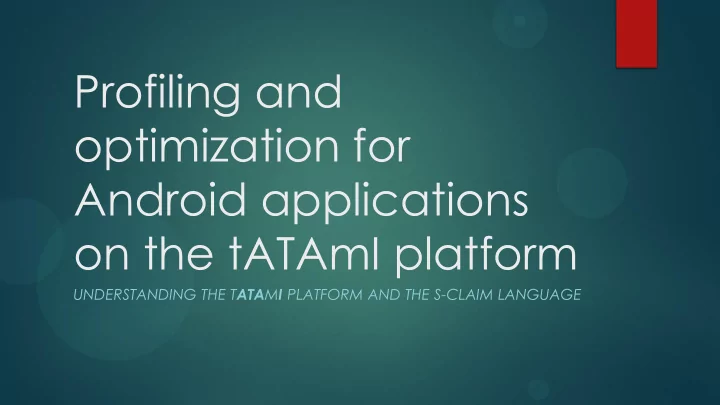

Profiling and optimization for Android applications on the tATAmI platform UNDERSTANDING THE T ATA M I PLATFORM AND THE S-CLAIM LANGUAGE
Outline Intro The tATAmI Platform S-CLAIM An Example Scenario (ProCon Android App)
Intro Starting with A collaborative effort of Andrei Olaru, Thi Thuy Nga Nguyen and Marius- Tudor Benea seeking a platform for the deployment and testing of AmI applications . a diploma project that implements a simple scenario (The Android application) The goal is optimize the platform profile and solve performance issues in the Android app optimize it in order to offer an enjoyable experience to the user
tATAmI t owards A gent T echnology for A mbient I ntelligence Designed and built having the following requirements in mind: the use of a programming language for the high-level implementation of agents a modular and extendable structure deployablity on mobile devices traceability and visualization the use of scenario-based simulation the possibility of integration with other platforms and protocols
tATAmI – Structure The Core Component: Agent communication, mobility, and management - JADE agents are used. Hierarchical mobility for agents - protocols and behaviors that allow agents to automatically move together with their parents. Web service access S-CLAIM interpretation and execution - a parser for S-CLAIM agent description files Knowledge Base - an interchangeable component that allows access to knowledge through a standard set of functions Context-awareness - use of context matching for problem solving and exchange of relevant context information.
tATAmI – Structure (cont.) The Simulation component: serving for the repeatable execution of scenarios Uses as input XML files that define the execution scenario. Deploys the agents according to the scenarios The Visualization Component Receives log reports and mobility events from agents Displays all agent logs in a centralized, chronological manner Provides components for the automatic layout of agent windows on the screen of the machine they execute on
tATAmI – Structure (cont.) Scenario CLAIM Knowledge specification Representation Specification CLAIM parser Knowledge Base Scenario Logging Visual Context agent Simulation XML WS Mobile device CLAIM Parsing Access Window Agent agent Layout Jade+ Hierarchies Simulation Core Visualization
tATAmI - SCENARIOS specified by means of an XML file that contains info about: The initial knowledge of Agents events to generate The purpose of a scenario is to reproduce an execution the mentioned information is all that is needed for this execution.
S-CLAIM S mart C omputational L anguage for A utonomous I ntelligent M obile agents An easy to use high-level declarative Agent-oriented programming language that was created to allow the representation of cognitive skills such as beliefs, goals and knowledge, Allows programmers to use the agent-oriented paradigm during the whole process of designing and implementing an AmI application, as it specifies only agent-related components and operations, leaving algorithmic processes aside
S-CLAIM - SEMANTICS Communication: Control primitives: send condition receive if Wait Mobility: in out Knowledge management addK Agent management: removeK open readK acid forAllK new
S-CLAIM - SYNTAX uses the notion of Blocks (<keyword> ) Variables ?? re-assignable. or ?not 3 Types of behaviors (agent SimpleAgent ?destination initial (behavior reactive (initial sender proactive (send ?destination (struct message hello)))))
JAVA FUNCTIONS There are processes that cannot be easily performed with the default primitives (S-CLAIM), this is why the developer can attach one or more Java class files all java-functions share the same signature (except for the name, obviously); they take a vector of values as an argument and return a boolean for the agent to use java functions, it has to contain a parameter specifying the *.java file which includes the needed functions Examples in the next section
A PC/ANDROID SCENARIO (The ProCon Debate App) Allows users to debate over a subject using their mobile java-based devices By typing their opinions and sending them After classifying each opinion as either positive (Pro) or negative (Con)
A PC/ANDROID SCENARIO (The ProCon Debate App) Agent Structure There are three types of agents in this application that do all the work: PDAAgent • EmissaryAgent • GroupCoordinatorAgent •
A PC/ANDROID SCENARIO (The ProCon Debate App) Joining a Group
A PC/ANDROID SCENARIO (The ProCon Debate App) Adding an opinion
A PC/ANDROID SCENARIO (The ProCon Debate App) Deleting an opinion
A PC/ANDROID SCENARIO (The ProCon Debate App) Leaving a Group (and joining another one)
FUTURE WORK Since the tATAmi platform had recently been re-structured, the application must be ported fully to it making the necessary changes. More actions could be added to the Agents making the application richer. an editor that allows developers to write S-CLAIM code easily and elegantly would be a very nice addition, offering some of the following features: Open the specific type of Agent file (*.adf2). Color and suggest auto-completion for S-CLAIM keywords. Find the existing variables and method in the *.java/xml files in the same project and also color and suggest auto-completion for them while typing S-CLAIM code. A kind of a "run" command/visual-button for the file (of the specific type) to check if it follows some specific syntactic rules or not. Showing errors and the line numbers in which they occurred.
Recommend
More recommend